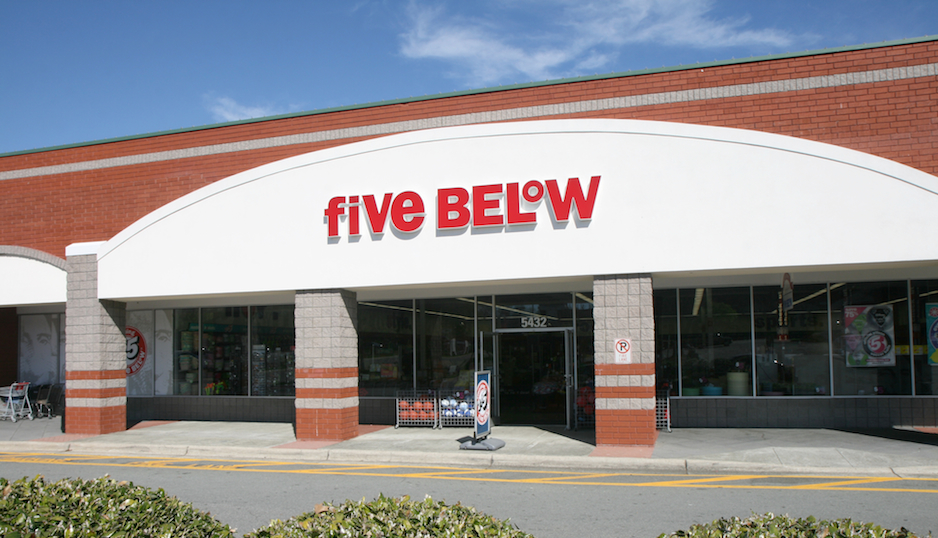BizFeed: Five Below Sales Soar
1. Five Below’s Earnings Strong Again
The News: Philly-based Five Below reported that sales climbed 22 percent in the first quarter — sending shares climbing in after-hours trading. Before the market opened on Thursday, the stock price was $35.10.
The Street offers this recap on the fast-growing, teen-focused retailer:
Earnings per share came in at $0.08, beating the $0.07 analysts polled by Thomson Reuters were looking for. During the same quarter last year, the company reported net income of $0.06.
As for revenue, sales stood at $153.7 million, amid estimates of $151.3 million. Last year, Five Below’s sales came in at $126 million, representing a 22% increase.
Why it Matters: Five Below stock had fallen 14 percent this year, a figure that’s sure to change upon this strong earnings report. In many ways, the brand is becoming the dollar store for kids, selling items like cell phone cases, candy, yoga mats, nail polish and decorations for between $1 and $5. And the company’s expansion plans are extremely ambitious — in fact, it opened 19 new locations in the first quarter, some in new markets like Kentucky and Alabama. CEO Joel Anderson said in an earnings call that the company is on track to open 70 new stores in 2015, entering six new states.
2. Redeveloping the Ridge Ave. Business District in N. Philly
The News: Philadelphia Housing Authority announced an ambitious plan to redevelop a decaying portion of North Philadelphia. It’s the area called Sharswood, which spans Ridge Avenue from Girard College to Cecil B. Moore Avenue.
Newsworks has more on the plan:
That would mean acquiring more than 1,300 properties through eminent domain for a mix of residential and commercial development. The agency plans to use some 300 parcels to build a brand new headquarters.
From the Inquirer:
This fall, the Blumberg towers are scheduled to be demolished and replaced over time by 1,203 homes and apartments.
But the project extends beyond housing. The PHA wants to build its headquarters on Ridge Avenue. About 300 of the parcels to be acquired sit on the Ridge Avenue corridor.
Why it Matters: A redevelopment of the Ridge Ave. business corridor couldn’t come too soon — and if it works, it could create a very sought-after neighborhood. It’s basically the connection between Spring Garden Street and Brewerytown and it’s not only close to Center City but also to thriving areas like Northern Liberties and Fishtown.
PHA President Kelvin Jeremiah called it “the single most important redevelopment in the city,” according to the Inquirer.
Here’s more from Jeremiah from Newsworks:
“We have to be better neighbors. We cannot only do housing without a corridor that provides the level of amenities that residents in Center City, for example, enjoy. It’s what sustains community development.”
3. Dish and T-Mobile Could Merge
The News: Dish Network and T-Mobile are in merger talks, according to the Wall Street Journal. The talks are still in the early stages.
Why it Matters: The deal “would accelerate a wave of consolidation across the U.S. media and communications industries,” the WSJ said.
From WSJ:
A Dish deal with T-Mobile would combine the country’s second-largest satellite TV operator with its fourth-largest wireless carrier. It would also address major strategic issues for both sides.
Dish lacks the robust broadband Internet service that cable companies can lean on to offset a declining TV business. It also has amassed billions of dollars of wireless licenses but hasn’t built the cellular network needed to put them to use. T-Mobile’s wireless service would help address both needs.
T-Mobile, meanwhile, has added subscribers at an industry-leading rate over the past several quarters, but still is dwarfed by much bigger rivals AT&T and Verizon Communications Inc. Dish’s wireless licenses would give T-Mobile a path to boosting the capacity of its network.



